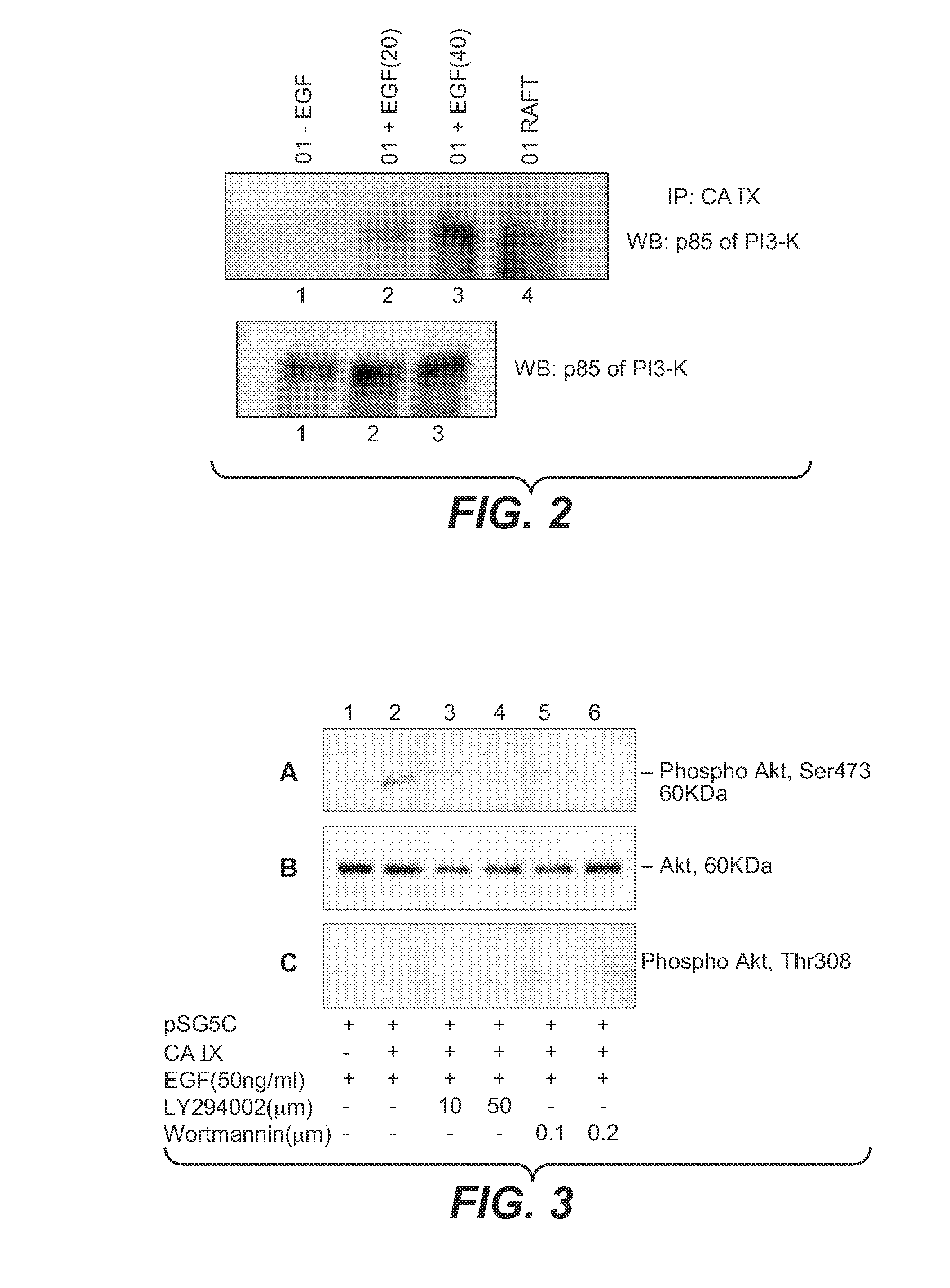MN/CA IX and EGFR Pathway Inhibition
a technology of egfr and ix, applied in the field of medical genetics, can solve problems such as cell death, and achieve the effect of inhibiting phosphorylation
- Summary
- Abstract
- Description
- Claims
- Application Information
AI Technical Summary
Benefits of technology
Problems solved by technology
Method used
Image
Examples
example 1
Intracellular Domain of CA IX can be Phosphorylated in an EGF Dependent Manner
[0190]Since epidermal growth factor receptor (EGFR) signaling is critically modulated by its localization in cholesterol rich membranes, and since its overexpression is well documented in the poor prognosis of renal cell carcinoma, the inventor investigated the effect of EGFR dependent signaling on the phosphorylation status of CA IX [Sun et al., Biochemistry, 41: 6338-6345 (2002); Dancey, J E, J Clin Oncol 22: 2975-2977 (2004)]. The results of these studies are shown in FIGS. 1A-C. The CA IX expressing SKRC-01 cells were serum starved and stimulated with increasing amounts of recombinant EGF and the RIPA extracts were made from these stimulated cells. These extracts were used in immunoprecipitation experiments with a polyclonal antibody to CA IX and the immune complexes collected were run on a denaturing polyacrylamide gel. The proteins transferred to PVDF membranes were probed for the presence of phospho...
example 2
Co-immunoprecipitation of Tyrosine Phosphorylated CA IX and p85 of PI3K
[0191]Some of the data from this study have indicated a functional cross-talk between CA IX and EGFR signaling pathways and suggests that the tyrosine phosphorylated version of CA IX could participate in the phosphatidyl inositol-3 Kinase (PI3K) signaling. To investigate this possibility, the inventor immunoprecipitated the serum starved and EGF stimulated extracts of SKRC-01 cells with the M75 monoclonal anti-CA IX antibody and probed the resulting blots for the possible association with PI3K. For this, a polyclonal antibody to the p85 subunit of the PI3K was used, which is shown in FIG. 2, upper panel. This figure shows that in the absence of any stimulatory signal, under completely serum starved conditions, there is no association of PI3K with the CA IX protein. This would be expected since the C-terminal Y is not phosphorylated under these conditions (lane 1). This figure also shows that there is an EGF conce...
example 3
Activation of Akt by CA IX-pY and PI3K Interaction
[0192]The inventor then investigated whether the PI3K activation by association with CA IX could be reproduced in a CA IX negative RCC cell line such as SKRC-17 upon transfection with a wild-type CA IX plasmid and to investigate whether this associated PI3K could be pharmacologically blocked. The results of these studies are shown in FIG. 3. SKRC-17 cells were transiently transfected with either the wild-type CA IX containing plasmid or the vector alone and were treated with inhibitors in the presence or absence of recombinant EGF. Initial transfection experiments incorporating negative controls which included empty vector plasmid (pSG5C) in the absence of stimulating EGF (i.e., CA IX- and EGF-) showed no phosphorylation of either Ser 473 or Thr 308 of the Akt enzyme, the target of PI3K. It is well known that the activation of PI3K is triggered by the binding of its SH2 domain containing p85 regulatory subunit to phosphorylated tyros...
PUM
| Property | Measurement | Unit |
|---|---|---|
| Force | aaaaa | aaaaa |
| Brinell hardness | aaaaa | aaaaa |
Abstract
Description
Claims
Application Information
 Login to View More
Login to View More - R&D
- Intellectual Property
- Life Sciences
- Materials
- Tech Scout
- Unparalleled Data Quality
- Higher Quality Content
- 60% Fewer Hallucinations
Browse by: Latest US Patents, China's latest patents, Technical Efficacy Thesaurus, Application Domain, Technology Topic, Popular Technical Reports.
© 2025 PatSnap. All rights reserved.Legal|Privacy policy|Modern Slavery Act Transparency Statement|Sitemap|About US| Contact US: help@patsnap.com



